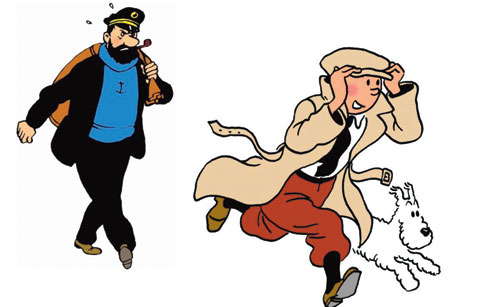
Great Snakes! It has been 88 years since the Belgian boy journalist, Tintin, first made an appearance. The young scribe was not exactly an instant success but his enduring appeal has ensured that more than 250 million copies of The Adventures of Tintin have been sold worldwide. This without taking into account the translations in over 70 languages. Tintin's creator, Hergé aka Georges Remi, was not afraid to wade into complicated subjects like history, politics and science, even though his primary readers were children. Yet, as Tintin's popularity grew and Hergé had to introduce more characters, his young readers posed a significant hurdle for him.
Captain Haddock, who can rival and, let's be honest, beat Tintin's charm, is a seafaring pipe-smoking merchant marine captain who likes his Loch Lomond whiskey and hates mineral water. But how could Hergé create a convincing alcoholic sailor without the swear words? The answer came in the form of whimsical and ingenious curses like "billions of blue blistering barnacles" and "ten thousand thundering typhoons". When the going got really tough the barnacles are also known to have become either boiled or barbecued or been at the mercy of those ten thousand thundering typhoons.
The Captain did not restrict himself to just the sea or its creatures either. "Bald-headed budgerigar", "Cachinnating cockatoo", "Lily-livered landlubbers" and "Macrocephalic baboon" are some of the other expletives the short-tempered sailor favoured when caught in a sticky situation. Then there are the more controversial abuses that Haddock is known to have hurled occasionally, such "Aztecs", "Polynesians" and "Bashi-bazouks", which earned his maker the racist tag.
Haddock's colourful vocabulary though, has always been close to the argument-loving Bengali's heart. In fact, Tintin first arrived in India when the Bengali children's magazine, Anandamela, began to publish the translated comics in 1975. Nirendranath Chakraborty, the famous poet who translated the comics, managed to capture the inherent mood of the original. But at the same time, Chakraborty used the subtle nuances of language to suit an audience who would not recognize the original cultural references. In the process, the characters became uniquely Bengali. So billions of blue blistering barnacles became "jotto sob gneri-gugli-r jhnak" and the Captain substituted "Sea-gherkin! Pirate! Logarithm! Ectoplasm! Baboon!" with " Tiktiki! Girgiti! Goshaap! Baboon! Banor!" to suit the irate Bengali's palate.










